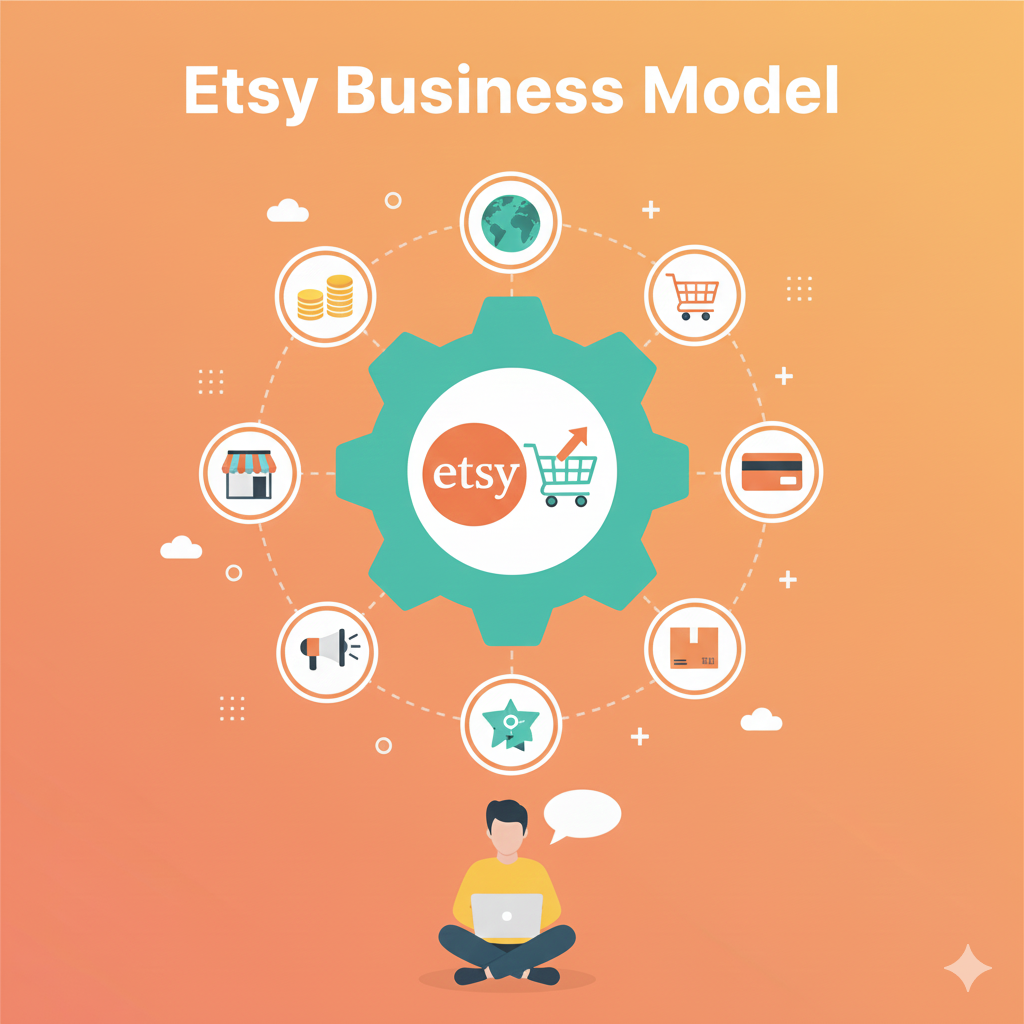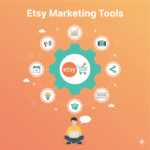If you’ve ever thought about selling on Etsy the first thing you should understand is how Etsy truly works behind the scenes. Etsy is not just another marketplace. It’s a unique ecosystem built specifically for handmade creators, digital product sellers, vintage curators, and small businesses that want to stand out.
And honestly, Etsy’s business model is one of the smartest in the online marketplace world. It’s profitable, scalable, and designed so that the platform grows automatically as sellers grow.
In this detailed guide, I’ll break down:
- What Etsy really is
- How Etsy makes money
- Deep dive into Etsy’s business operations
- A full Etsy Business Model Canvas
- Why Etsy’s model works so well
- Lessons creators and eCommerce entrepreneurs can learn from Etsy
Let’s start from the basics.
What Exactly Is Etsy?
Etsy is a global online marketplace that focuses on:
- Handmade products
- Craft supplies
- Vintage items
- Unique and customized gifts
- Art and creative goods
- Digital downloads (printables, templates, planners, etc.)
- Print-on-demand designs
Unlike Amazon or eBay, Etsy isn’t built for mass production. It’s built for creativity and individuality — and this positioning is exactly what makes its business model special.
Etsy didn’t try to compete with Amazon’s “everything store” model. Instead, it carved out a niche category that emotionally connects shoppers with creators.
This emotional connection is a big part of Etsy’s growth engine.
How Etsy Makes Money (Overview of All Revenue Streams)
Before we jump into the business model canvas, let’s quickly understand how Etsy earns. Etsy’s revenue model is primarily fee-based, meaning Etsy earns every time:
- A seller lists something
- A seller renews a listing
- A customer buys something
- A seller uses Etsy ads
- A shop uses Etsy Plus
- A seller uses Offsite Ads
- A transaction is processed
Here’s a simple breakdown.
Listing Fees
Every time a seller adds a product, Etsy charges:
$0.20 per listing (valid for 4 months)
If the product sells, Etsy renews it and charges again.
This creates continuous small income from active shops.
Transaction Fees
When a buyer makes a purchase, Etsy takes:
6.5% of the order total
(including product price + shipping)
This is Etsy’s biggest revenue source.
Payment Processing Fees
Etsy Payments adds another fee, often around:
3% + a fixed currency amount
This fee varies depending on country.
Etsy Ads (On-site Ads)
Sellers pay for ads that appear inside Etsy search results.
Etsy charges per click, even if the buyer doesn’t purchase.
Offsite Ads
Etsy runs paid ads for listings on Google, Pinterest, Meta, etc.
If the sale comes through those ads, Etsy charges 12–15% of the sale.
This revenue is recurring and grows automatically with more sellers.
Etsy Plus Subscription
Etsy offers a premium subscription at around $10/month, which includes:
- Shop customization options
- Monthly ad credits
- Additional features
- Discounts on packaging
Pattern Website Subscription
Pattern (Etsy’s website builder) also adds recurring subscription revenue.
Other Revenue Sources
- Shipping label fees
- Currency conversion fees
- Seller services
- Data and marketplace insights
Now that you know how Etsy earns, let’s understand its strategic model using the Business Model Canvas framework.
Etsy Business Model Canvas (Full, Detailed Breakdown)
Below is a complete, deep explanation of Etsy’s entire business model in the 9 sections of the Business Model Canvas.
Customer Segments
Etsy serves two core groups:
1. Sellers (Creators and Small Business Owners)
These include:
- Handmade and craft creators
- Digital product sellers
- Vintage product shops
- Jewelry designers
- Wedding product creators
- Artists and illustrators
- Print-on-demand sellers
- Home décor creators
- Niche hobby sellers (knitting, woodworking, etc.)
Why sellers choose Etsy:
- Easy setup
- Ready-made global audience
- Built-in SEO traffic
- Low cost of starting
- No coding or website building needed
- Ideal for niche and creative businesses
2. Buyers (People Looking for Unique or Personalized Items)
Etsy buyers usually want:
- Personalized gifts
- Custom handmade items
- Wedding items
- Baby apparel
- Home décor
- High-quality craft supplies
- Unique fashion pieces
- Digital resources (templates, planners, art)
These buyers want creativity and emotion — not mass-produced products.
Value Proposition
Etsy delivers value to both sellers and buyers in different ways.
Value for Sellers
- A global audience without needing marketing skills
- A platform built specifically for creative and handmade products
- Simple listing process
- Sales analytics
- On-platform ad options
- Low entry barrier
- Built-in trust and credibility
- SEO-friendly marketplace
Etsy lets anyone turn their hobby or talent into a business.
Value for Buyers
- Unique and personalized items they won’t find elsewhere
- Handmade products with emotional value
- Safe, trusted buying experience
- Global access to creative sellers
- High-quality curated marketplace
- Items suited for gifting, weddings, events, holidays
This emotional appeal is Etsy’s strongest competitive advantage.
Channels (How Etsy Reaches Buyers & Sellers)
Etsy attracts traffic through:
- Etsy marketplace website
- Etsy mobile apps
- Search engines (Google, Bing)
- Pinterest traffic (Etsy dominates Pinterest)
- Instagram marketing
- Affiliate partnerships
- Influencer content
- Etsy email recommendations
- Etsy SEO (internal search rankings)
- Offsite Ads on social media platforms
A large percentage of traffic is organic from Etsy search and Pinterest.
Customer Relationships
For Sellers
- Seller dashboard
- Listing tools
- SEO and analytics reports
- Help center and tutorials
- Seller community forums
- Direct customer messaging
- Ad management tools
For Buyers
- Secure payment system
- Reviewed and trusted sellers
- Purchase protection
- Recommendations based on browsing
- Saved favorites and collections
- Easy checkout experience
Etsy builds loyalty through trust, a safe shopping environment, and personal interactions between sellers and buyers.
Revenue Streams
To summarize clearly, Etsy earns from:
- Listing fees
- Renewal fees
- Transaction fees
- Etsy Payments processing fees
- On-site Etsy Ads
- Offsite Ads fees
- Etsy Plus subscription
- Pattern subscription
- Currency conversion fees
- Shipping label fees
This gives Etsy a balanced, recurring, and scalable revenue system.
Key Activities
These are the main things Etsy must do to run the marketplace:
- Maintain the platform and mobile apps
- Improve search algorithm and ranking quality
- Maintain marketplace trust and safety
- Detect fraud or policy violations
- Promote the marketplace globally
- Run advertising partnerships
- Support both sellers and buyers
- Expand features for shops
- Manage dispute resolution
- Process secure payments
Technology, trust, and traffic are Etsy’s top activities.
Key Resources
The most important resources Etsy owns:
- The Etsy platform (website + app)
- Search and recommendation algorithms
- Massive community of sellers and buyers
- Brand reputation
- Payment systems
- Marketing and ads infrastructure
- Seller tools and analytics
- Partnerships with Google, Meta, Pinterest, etc.
- Product policies and legal framework
This combination makes Etsy extremely defensible and hard to copy.
Key Partners
Etsy relies on:
- Payment processors
- Shipping and logistics partners
- Advertising networks
- Third-party integrations
- Print-on-demand providers (via sellers)
- Fraud detection partners
- Compliance and legal networks
These partners allow Etsy to provide a global experience without owning physical operations.
Cost Structure
Etsy’s main costs include:
- Product engineering and technology
- Server management and hosting
- Customer support teams
- Marketing and advertising expenses
- Payment processing
- Operational and administrative costs
- Global expansion
- Research and development
- Marketplace trust and safety systems
Even though expenses are high, Etsy is profitable because it has no inventory or logistics costs — everything is seller-driven.
Why Etsy’s Business Model Works So Well
Here’s the real reason Etsy succeeded:
It chose a niche that emotionally connects buyers and sellers.
Other marketplaces focus on:
- Low prices
- Fast shipping
- Mass-market goods
Etsy focuses on:
- Creativity
- Personalization
- Meaningful purchases
Etsy doesn’t try to be Amazon — and that’s exactly why it wins.
Some deeper reasons Etsy thrives:
1. Strong creator community
Sellers feel attached to Etsy because it celebrates their craft.
2. High repeat purchase rates
People buy again for:
- Birthdays
- Weddings
- Holidays
- Anniversaries
- Home decoration
- Seasonal events
3. Built-in trust system
Reviews, ratings, profiles, photos — everything adds authenticity.
4. Trend-driven shopping
Etsy grows when trends grow:
- Boho home décor
- Custom jewelry
- Digital planners
- Wedding templates
- Seasonal gifts
This keeps the marketplace fresh and evergreen.
5. No inventory or manufacturing
Etsy doesn’t own a single product.
The sellers handle everything.
This makes the business extremely scalable.
Lessons Entrepreneurs Can Learn From Etsy
If you’re building your own blog, eCommerce brand, or marketing platform, Etsy teaches some powerful lessons:
1. Focus on a specific niche instead of competing with big players
Etsy didn’t challenge Amazon — it built a unique marketplace.
2. Build emotional products
People pay more for items with meaning.
3. Create a community, not just a marketplace
Sellers and buyers feel connected to Etsy’s identity.
4. Keep your business scalable
No warehouses.
No inventory.
No manufacturing.
Etsy focuses on technology and marketplace management.
5. Make the platform win when users win
Every time a seller succeeds, Etsy earns more.
This win-win model helps Etsy grow consistently.
Conclusion
Etsy’s Business Model is a perfect example of how a niche-focused marketplace can grow into a global brand without owning a single product. It focuses on creativity, authenticity, emotional value, and community and that’s why both sellers and buyers love it.
The Business Model Canvas clearly shows that Etsy thrives because:
- It connects two sides (buyers & sellers)
- It earns through scalable, recurring fees
- It requires minimal operational risk
- It grows automatically as shops grow
- It wins by supporting creativity and personalization
Understanding this model helps you:
- Build your Etsy shop with the right strategy
- Analyze marketplace ecosystems
- Write better eCommerce content
- Create your own business frameworks
- Think like a platform owner
Discover more from PratsDigital
Subscribe to get the latest posts sent to your email.

